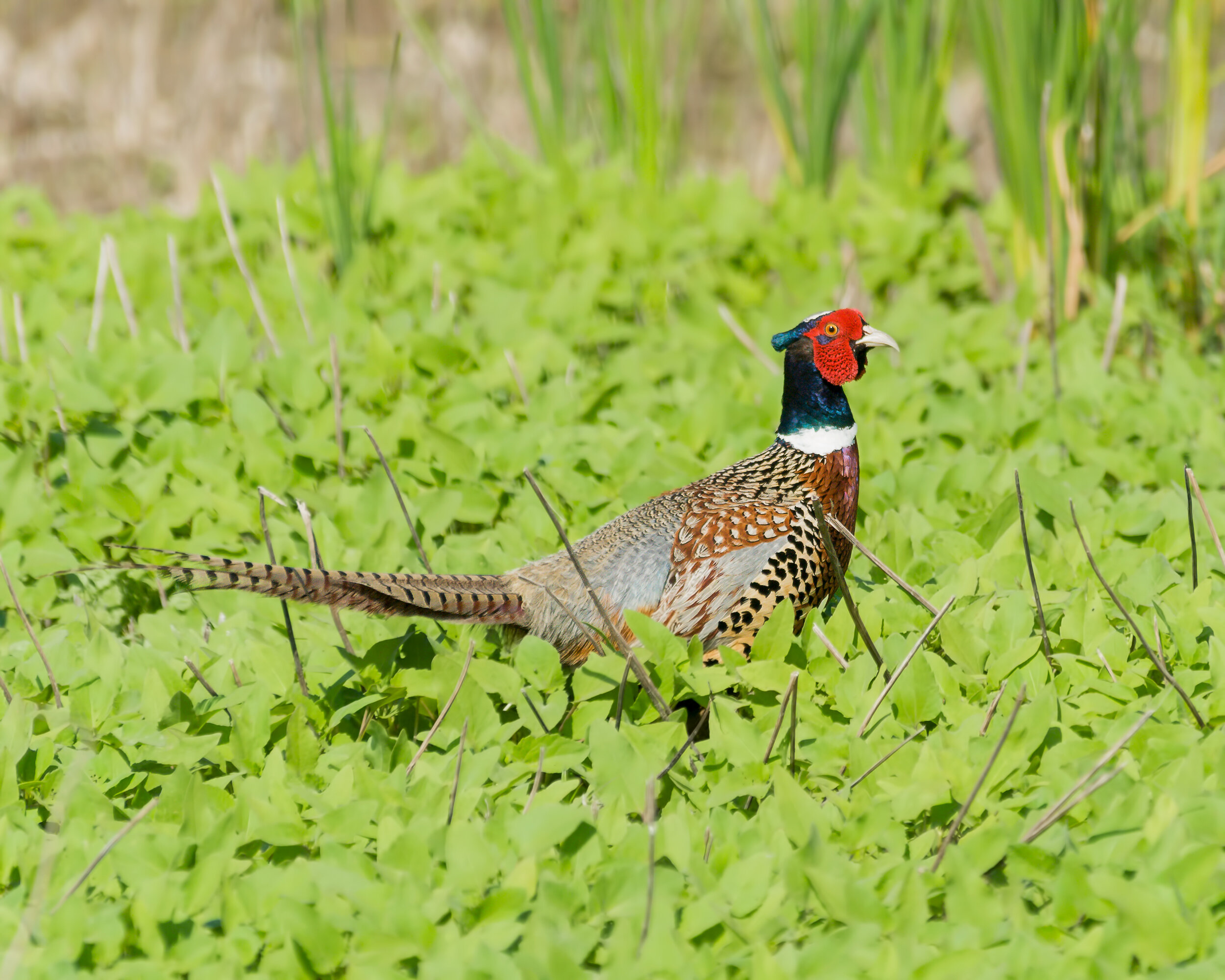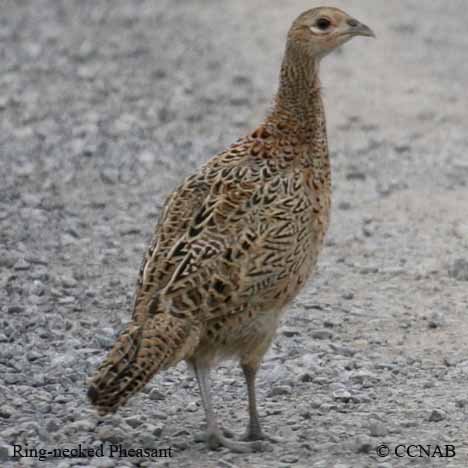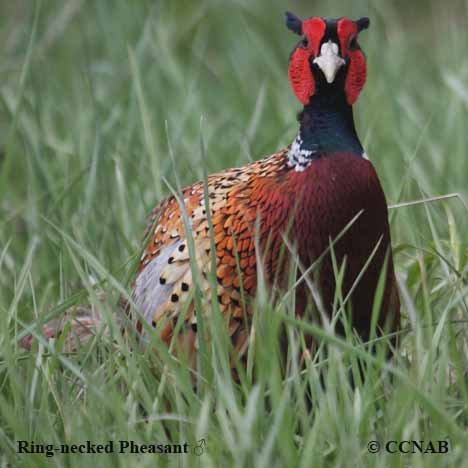Adult Male Ring-necked Pheasant, Image by Daniel Lee Brown
This month, let’s talk about a local, non-native species called the Ring-necked Pheasant, which is also known as Common Pheasant. Ring-necked Pheasants originally came from China and other parts of Asia. They were introduced to the United States in 1881 from China as a game bird (a bird hunted for sport or food). Game birds are in a large group that includes pheasants, wild turkey, chukar, grouse, quails, guineafowl, guans, etc.). The largest North American populations of Ring-necked Pheasants are located in the central United States and southern Canada. Young birds may roam after leaving their nest sites to find a new area to live. However, Ring-necked Pheasants are not considered migratory and tend to stay in a general area from generation to generation. They are usually seen alone in the wild; but are known to gather in flocks during the winter. Most of the time, Ring-necked Pheasants either walk or run on the ground. However, when frightened or threatened, they can immediately burst almost vertically into the air using their powerful and specialized (unique) chest muscles. They usually fly only for short distances when necessary.
What do Ring-necked Pheasants look like?
Adult Male Ring-necked Pheasant, Image by Mary Forrestal
It may be difficult to get more than a quick glimpse of a Ring-necked Pheasant because they can be hidden in their dense habitat. Ring-necked Pheasants are large birds that have long tails, curved bills, and short, rounded wings. Males and females look very different. Male Ring-necked Pheasants are eye-catching due to their brightly colored plumage (feathers). Males have gold, copper or rust, and brown plumage on their bodies with black and white spots. The heads and necks of male Ring-necked Pheasants are green, bluish-black, or purple. Their feathers are shiny and iridescent, (changes in color depending on how the angle of the light). Male Ring-necked Pheasants have bright red patches around their eyes and faces, a white neck collar (or ring) (which is not always visible), and ear tufts which sometimes extend past the back of their heads. Female birds are fairly drab (or dull in color). This allows them to blend into field habitats while nesting or caring for their young. Compared with males, female Ring-necked Pheasants are lighter in color overall, smaller, and have shorter tails. They have sandy-brown plumage with dark brown-black markings on their backs, heads, and wings and pale chests.
Adult Female Ring-necked Pheasant, Photo is from Classic Collection North American Birds, Birds-of-North-America.net, used by permission
Where do Ringed-necked Pheasants live?
Juvenile Male Ring-necked Pheasant, Image by Daniel Lee Brown
Ring-necked Pheasants are found in grassy woodland edges, areas with tall vegetation, open fields, brushy grassland areas, farmlands, pastures, weedy roadsides, prairies, cattail wetlands or marshes, and suburban gardens. They tend to be in areas that are near streams, brooks, or even constructed water channels. Ring-necked Pheasants tolerate human presence fairly well and are often seen in the outskirts of major cities. They usually roost (rest and sleep) in trees or tall bushes.
The nests of Ring-necked Pheasants are built on the ground under thick cover. Nests can be found along fence lines or in ditches. The female Ring-necked Pheasant chooses the nesting site and constructs a simple nest which is about 7 inches across and 3 inches deep. She uses feathers, grasses, and other plant materials to line the nest. The usual clutch size (a group of eggs in a nest) is between 10 and 12 eggs. Ring-necked Pheasant chicks are born with their eyes open and are covered with very soft feathers, called down. At only two hours of age, the chicks are able to leave the nest and start looking for food with their mothers. Young birds will remain close to their mothers for 10 to 12 weeks.
What do Ring-necked Pheasants eat?
Adult Male Ring-necked Pheasant, Photo is from Classic Collection North American Birds, Birds-of-North-America.net, used by permission
Ring-necked Pheasants are omnivorous (eat foods either of plant or animal origin). They scratch the ground with their feet to find food and will also dig for roots or seeds with their powerful bills. Their diet changes throughout the year with the seasons. Adult Ring-necked Pheasants eat insects, spiders, grain and other agricultural crops, seeds, roots, wild fruits, nuts, snails, and earthworms. They also will eat leaves, buds, flowers, and occasionally small reptiles or rodents. In bad weather, Ring-necked Pheasants can go up to two weeks without eating. This is because their bodies have the capability to adjust their metabolism (chemical processes in the body) which acts to reduce their energy requirements. Ring-necked Pheasant chicks eat grasshoppers and other insects for the first six weeks of their lives before switching to a more varied diet.
What do Ring-necked Pheasants sound like?
The sounds that Ring-necked Pheasants make are described as hacking, crowing, or cackling. They also make a rapid wing-beat noise that can be either soft or loud. The ‘crowing’ sound is only made by males. You can listen to Ring-neck Pheasants now.
These calls of the Ring-necked Pheasant are from xeno-canto. More Ring-necked Pheasant vocalizations can be found at xeno-canto.org/species/Phasianus-colchicus.





